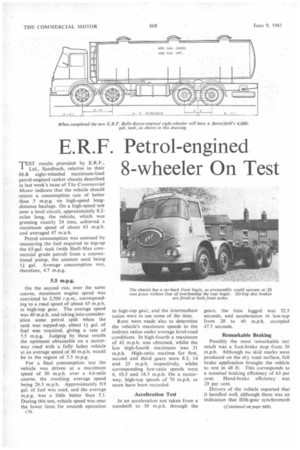E.R.F. Petrol-engined 8-wheeler On Test
Page 78

Page 83

If you've noticed an error in this article please click here to report it so we can fix it.
TEST results provided by E.R.F., Ltd., Sandbach, relative to their 88.R eight-wheeled maximum-load petrol-engined tanker chassis described in last week's issue of The Commercial Motor indicate that the vehicle should return a consumption rate of better than 5 m.p.g. on high-speed longdistance haulage. On a high-speed test over a level circuit, approximately 8.2miles long, the vehicle, which was grossing exactly 24 tons, achieved a maximum speed of about 63 m.p.h. and averaged 47 m.p.h.
Petrol consumption was assessed by measuring the fuel required to top-up the 65-gal. tank (with Shell-Mex commercial grade petrol) from a conventional pump, the amount used being 11gal. Average consumption was, therefore, 4.7 m.p.g.
5.5 m.p.g.
On the second run, over the same course, maximum engine speed was restricted to 2,500 r.p.m., corresponding to a road speed of about 45 m.p.h. in high-top gear. The average speed was 40 m.p.h. and taking into considerWon some petrol spilt when the tank was topped-up, about gal. of fuel was required, giving a rate of 5.5 m.p.g. Judging by these results the optimum obtainable on a motorway road with a fully laden vehicle at an average speed of 40 m.p.h. would be in the region of 5.5 m.p.g.
For a final consumption test the vehicle was driven at a maximum speed of 30 m.p.h. over a 4.6-mile course, the resulting average speed being 26.3 m.p.h. Approximately 0.9 gal. of fuel was used, and the average m.p.g. was a little better than 5.1. During this test, vehicle speed was near the lower limit for smooth operation c36 in high-top gear, and the intermediate ratios were in use some of the time.
Runs were. made also to determine the vehicle's maximum speeds in the indirect ratios under average level-road -conditions. In high-fourth a maximum of 42 m.p.h. was obtained, whilst the low high-fourth Maximum was 31 m.p.h. High-ratio maxima for first, second and third gears were 8.5, 14 and 25 m.p.h. respectively, whilst corresponding low-ratio speeds were 6, 10.5 and 18.5 m.p.h. On a motorway, high-top speeds of 70 m.p.h. or more have been recorded.
Acceleration Test
in an acceleration test taken from a standstill to 30 m.p.h. through the gears, the time logged was 32.5 seconds, and acceleration in low-top from 20 to 40 m.p.h. occupied 47.5 seconds.
Remarkable Braking
Possibly the most remarkable test result was a foot-brake stop from 30 m.p.h. Although no skid marks were produced on the dry road surface, full brake application brought the vehicle to rest in 48 ft. This corresponds to a nominal braking efficiency of 63 per cent. Hand-brake efficiency was 29 per cent.
Drivers of the vehicle reported that it handled well, although there was an indication that fifth-gear synchromesh was not fully effective towards the end of the final test run. Except when making the low-speed fuel consumption test, the high ratio of the Eaton two-speed axle was in use for the majority of the time the vehicle was under test.
Engine Comparison In matching the value of the RollsRoyce petrol engine's relatively low weight against its higher fuel consumption and slightly reduced acceleration performance compared with a modern diesel engine of equivalent output, it is pertinent that the tanker will probably average over 50,000 miles per year, a substantial proportion of which will be covered on motorways. In the main.
the vehicle will be laden in one direction only.
If a vehicle of this type were employed for the carriage of oil products, the useful payload would probably be in the region of 17 tons. In the case of heavy fuel oil, this would enable a load of 4,000 gal. to be carried, whilst the maximum gallonage of motor spirit would be 5,000 gal. Quiet operation of the power unit while discharge-pumping would be of particular advantage when making night deliveries in residential areas.
















































































































































